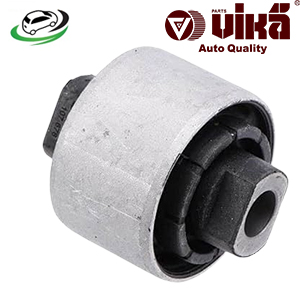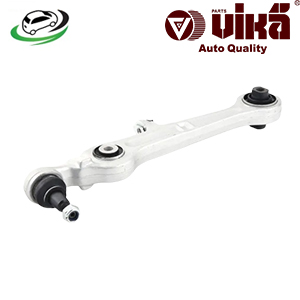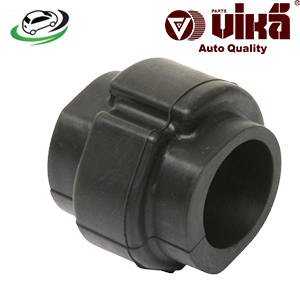-33%
Get Front Stabiliser Mounting Bush Audi B6 A4/Audi B6 S4/Audi B7 A4/Audi B7 RS4/Audi B7 S4/Audi R8 4D0411327J
A stabilizer mounting bush, often referred to as a sway bar bushing, is a small but crucial component of a vehicle’s suspension system. It helps to stabilize the vehicle during turns and improves overall handling. This guide will cover the function, types, benefits, maintenance, and common issues associated with stabilizer mounting bushes in detail.
Function of a Stabilizer Mounting Bush
Stabilizing the Vehicle
The primary function of a stabilizer mounting bush is to reduce body roll when a vehicle goes around a corner or makes a sharp turn. It achieves this by securely mounting the stabilizer bar (or sway bar) to the vehicle’s chassis, allowing the bar to resist lateral forces and keep the vehicle more level.
Vibration Dampening
Stabilizer mounting bushes absorb and dampen vibrations and shocks from the road. This helps to provide a smoother ride and protects other suspension components from excessive wear.
Noise Reduction
By isolating the stabilizer bar from the vehicle’s chassis, the bushes help to reduce noise and harshness that can be transmitted into the cabin, contributing to a quieter and more comfortable ride.
Types of Stabilizer Mounting Bushes
- Rubber Bushes
- Construction: Made from high-density rubber.
- Advantages: Provides excellent vibration isolation and is cost-effective.
- Disadvantages: Can wear out relatively quickly and may deteriorate due to exposure to heat, oil, and other elements.
- Polyurethane Bushes
- Construction: Made from durable polyurethane material.
- Advantages: More resistant to wear and tear, oil, and other contaminants. Offers better performance in terms of handling and responsiveness.
- Disadvantages: Can be stiffer than rubber bushes, potentially transmitting more vibrations to the chassis.
- Hybrid Bushes
- Construction: Combine elements of both rubber and polyurethane.
- Advantages: Aim to provide a balance between comfort and durability.
- Disadvantages: May be more expensive and complex to manufacture and replace.
Benefits of High-Quality Stabilizer Mounting Bushes
Enhanced Handling and Stability
High-quality bushes improve the vehicle’s handling and stability by maintaining a firm connection between the stabilizer bar and the chassis. This allows the stabilizer bar to function effectively, reducing body roll and improving cornering performance.
Increased Durability
Durable bushes are less likely to deteriorate quickly, which means they provide consistent performance over a longer period. This reduces the frequency of replacements and maintenance costs.
Improved Ride Comfort
By effectively isolating vibrations and reducing noise, high-quality bushes contribute to a smoother and quieter ride. This enhances overall driving comfort, especially on rough or uneven roads.
Protection of Suspension Components
Quality bushes help to protect other suspension components from excessive wear and damage by absorbing shocks and vibrations. This extends the lifespan of the entire suspension system.
Maintenance of Stabilizer Mounting Bushes
Regular Inspection
- Visual Checks: Regularly inspect the bushes for signs of wear, cracks, or deterioration. Look for any deformation or oil contamination.
- Noise and Handling: Pay attention to any unusual noises or changes in vehicle handling, which can indicate worn or damaged bushes.
Lubrication
- Proper Lubrication: Some bushes, particularly polyurethane ones, may require lubrication to prevent squeaking and ensure smooth operation. Use a suitable lubricant recommended by the manufacturer.
Cleaning
- Keep Clean: Ensure the bushes and surrounding areas are clean and free from dirt and debris. This helps to prevent premature wear and tear.
Replacement Intervals
- Manufacturer’s Recommendations: Follow the vehicle manufacturer’s guidelines for inspecting and replacing stabilizer mounting bushes.
- Signs of Wear: Replace the bushes if you notice any significant wear, cracks, or deterioration. Do not wait for complete failure, as this can affect vehicle handling and safety.
Common Issues with Stabilizer Mounting Bushes
Wear and Tear
- Symptoms: Increased body roll, clunking noises, and reduced handling performance.
- Causes: Over time, bushes can wear out due to constant stress, exposure to elements, and normal aging.
Cracking and Deformation
- Symptoms: Visible cracks in the bushes, changes in shape, and poor fitment.
- Causes: Exposure to extreme temperatures, oil, and other contaminants can cause rubber bushes to crack and deform.
Squeaking and Noise
- Symptoms: Squeaking or creaking noises, especially when turning or going over bumps.
- Causes: Lack of lubrication (in polyurethane bushes) or deteriorated rubber can cause noise.
Oil Contamination
- Symptoms: Softened or swollen bushes, reduced effectiveness.
- Causes: Exposure to engine oil or other fluids can degrade rubber bushes.
Replacement of Stabilizer Mounting Bushes
Tools and Equipment
- Basic Tools: Wrenches, socket sets, screwdrivers, and a jack and jack stands.
- Replacement Bushes: Ensure the new bushes are compatible with your vehicle’s make and model.
Steps for Replacement
- Safety First: Ensure the vehicle is securely supported on jack stands or a lift before starting the replacement process.
- Locate Bushes: Identify the location of the stabilizer mounting bushes. They are typically found at the ends of the stabilizer bar where it attaches to the chassis.
- Remove Old Bushes: Remove the bolts securing the old bushes to the chassis and stabilizer bar. Carefully detach the old bushes.
- Clean Surface: Clean the mounting surfaces to ensure proper fitment of the new bushes.
- Install New Bushes: Place the new bushes in position, ensuring they are properly aligned. Secure them with the bolts, tightening to the manufacturer’s specifications.
- Lower Vehicle: Once the new bushes are installed and secured, lower the vehicle back onto the ground.
- Test: Test drive the vehicle to check for any unusual noises or handling issues, ensuring the new bushes are functioning correctly.
Professional Assistance
If you are unfamiliar with vehicle maintenance or the replacement process, it is advisable to seek professional assistance to ensure proper installation and avoid potential issues.
Follow us on Facebook for more parts.



